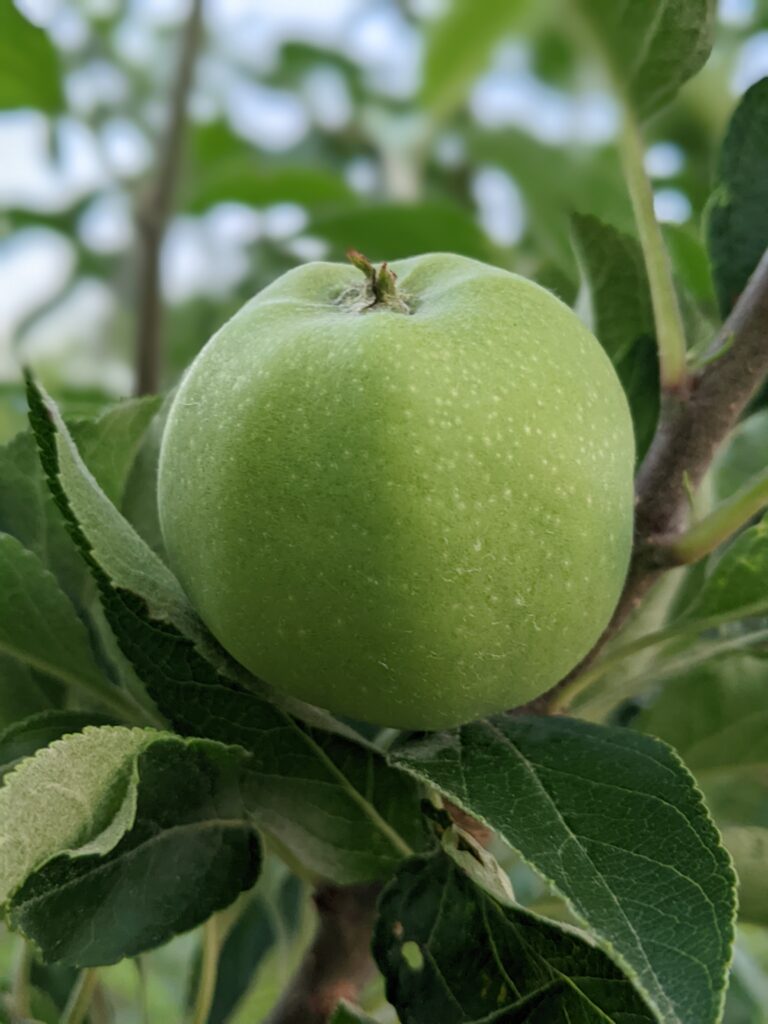One question that always comes up this time of year is how do I know when my fruit is ripe
It’s a question that new growers and seasoned orchardists both struggle with. I know that this time of year, I routinely refer to published dates to try and get ready for harvest. Fortunately there are several tools at your disposal for answering this question. Try your hand at determining if each statement is TRUE or FALSE
I can go by the suggested harvest period listed on internet sites to determine the right time for my fruit and variety
This statement is partially true and partially false. This timeframe can give you a general sense of when to start looking for ripe fruit. Many sites list information like “late summer” or harvest period “late.”. This will clue you into a general timeframe, but is fairly generic. Other reference are more specific–“late September/early October.” This is more helpful, but you must consider if the reference you are consulting lies in the same zone or similar growing conditions to your own. For example, a date of “August” for a Southern California website zone 10 bears little relevance for Virginia zone 6b. Look for a site which is closer to your own zone for best results.
When fruit starts to fall off the tree, I know the fruit is ready to be picked
 Another question that is partially true, but with a caveat. There may be some correlation between fruit drop and ripeness, but remember there are many reasons that fruit may begin to drop that is not in any way indicative of ripeness. Many fruits have a period commonly referred to as June drop when excess fruit is shed. Injured fruit with insect damage or rot can likewise drop early. While dropped fruit should be removed to lessen the chance of overwintering of pests, fruit drop is not the best gauge for fruit ripeness.
Another question that is partially true, but with a caveat. There may be some correlation between fruit drop and ripeness, but remember there are many reasons that fruit may begin to drop that is not in any way indicative of ripeness. Many fruits have a period commonly referred to as June drop when excess fruit is shed. Injured fruit with insect damage or rot can likewise drop early. While dropped fruit should be removed to lessen the chance of overwintering of pests, fruit drop is not the best gauge for fruit ripeness.
The color change of the fruit is a major clue to
what stage of ripening the fruit has reached
 This statement is TRUE. For example, most fruits change color as they near the point of ripeness. During ripening, chlorophyll breaks down and the underlying colors become visible. Know the base color for your particular fruit and use that color as a gauge whether your fruit is approaching ripeness. For some fruits that maintain a solid color throughout the growing period {like Granny Smith}, other means of determining ripeness must be used.
This statement is TRUE. For example, most fruits change color as they near the point of ripeness. During ripening, chlorophyll breaks down and the underlying colors become visible. Know the base color for your particular fruit and use that color as a gauge whether your fruit is approaching ripeness. For some fruits that maintain a solid color throughout the growing period {like Granny Smith}, other means of determining ripeness must be used.
This interesting photo shows a computer translation of the ripening color of a Golden Delicious apple.*
Ripe fruit detaches more easily from the tree
Yes, a TRUE statement. Try lifting the fruit up and to the side. If it detaches easily, the fruit is ready to be picked. If you find the fruit has to be pulled or twisted with some force and still refuses to come free, its not ready. Leave it for several more days or even a week.
Seed color has no relationship to ripeness
This statement is FALSE. The seeds or pips of fruit turn darker as they get closer to harvest. Fruit ready for harvest has dark brown or black seeds. Fruit with white seeds are just not ready to be picked. 
The best indication that fruit is ready to be picked is flavor
This statement is TRUE. As fruit ripens, starch is transformed into simple carbohydrates in the form of sugar. Dessert apples take on their characteristic sweet taste, while fresh eating apples may transform from bitter to a complex combination of acidity and sweetness that defines their unique variety.
All these steps can be used
to determine when your fruit
is ready for that delicious first bite!!

*Evaluation of the ripening stages of apple (Golden Delicious) by means of computer vision system. Accessed Sept 1, 2023 https://www.sciencedirect.com/science/article/abs/pii/S1537511016306936
![]()





Fruit is starting to ripen and I’m looking forward to tasting different varieties. What are your favorite apples?
My fruit have bruises. What can I do?
Some fruit are more subject to bruising than others. You might want to carry a basket with you when you harvest. Gently place each fruit into the container and don’t place too many on top of each other. Peaches are particularly susceptible to bruising. You might need to make several trips over time, selecting the most ripe fruit first.